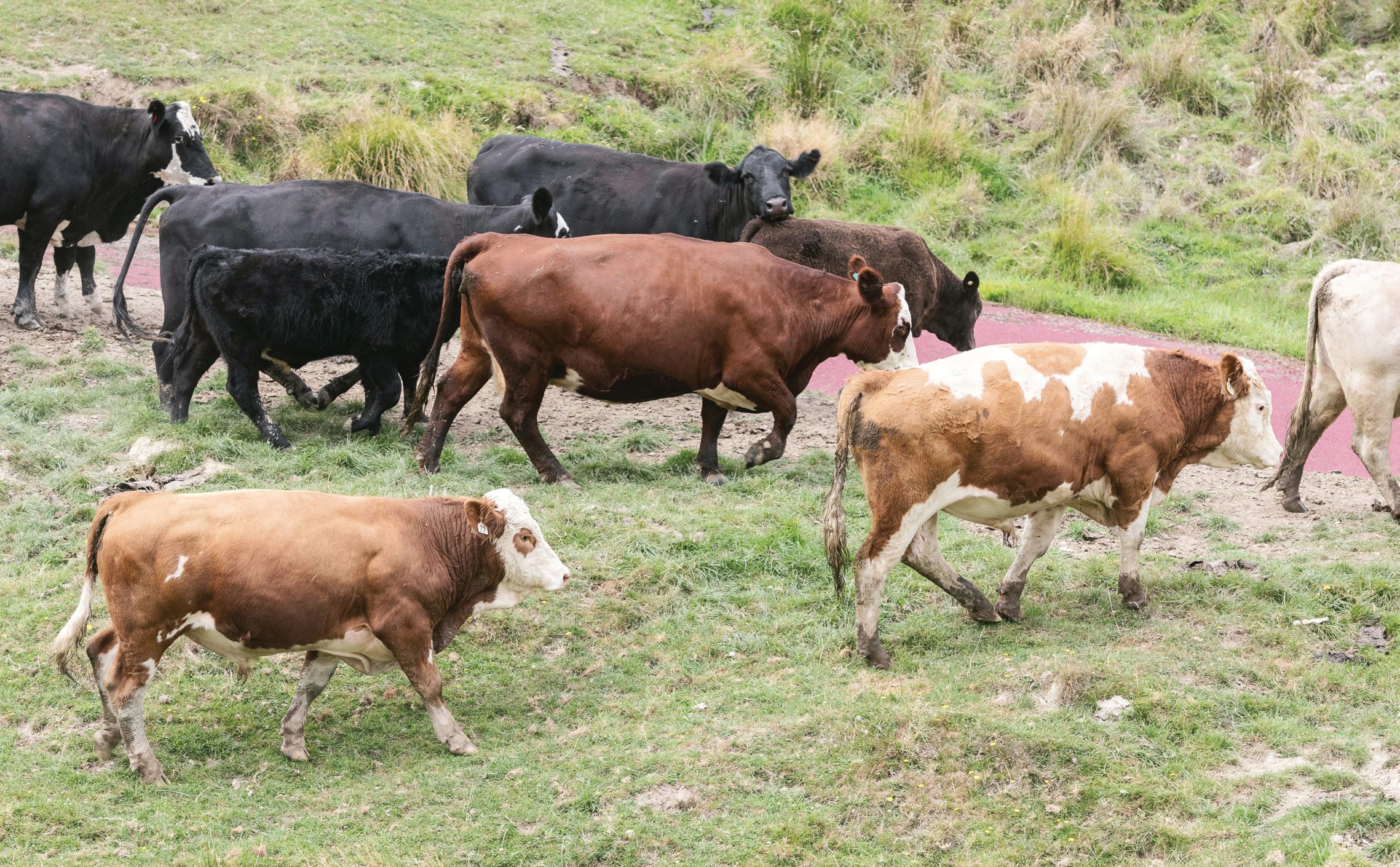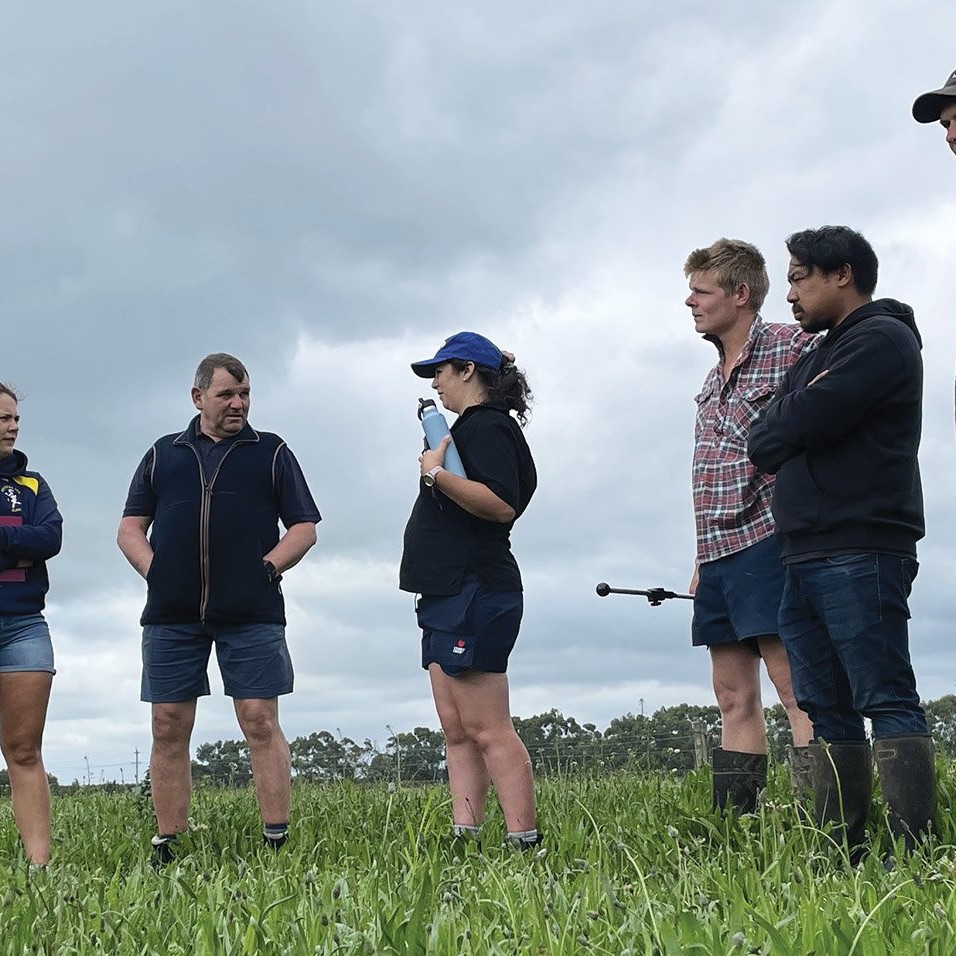A young Rangitikei couple are farming family lease blocks with the aim of eventually buying their own farm, Russell Priest writes. Photos: Brad Hanson.
Karl Farrell is a young man with a wise head on his shoulders.
He’s realised that the best way to make money off steep country is to keep farming processes simple, expenses low and to work towards achieving reasonable stock performance.
Karl (30) farms two lease blocks totalling 1060 hectares (900ha effective) in partnership with his parents, 13km south-west of Taihape. He also leases 360ha from his parents in the Kawhatau Valley, and helps local farmers with mustering.
Sharing the workload is his partner Michaela Hayes (30) with her team of nine dogs: five broken in; two in training and two fox terriers for entertainment.
“Our long-term goal is to buy our own farm but in the meantime leasing is working out well, allowing me to pay off my stock loan,” Karl says.
“I’m lucky as leases are not easy to come by.”
The better-developed of the two Taihape lease blocks (Tiri, 360ha) has been farmed by Karl and his parents for 15 years while the adjacent 700ha (600ha effective) “Ridge” block has been leased for a year.
Karl was only 21 when he got the call to come home and help manage the two blocks, due to his father’s health.
“I was probably too young and didn’t know enough, but by working on lots of farms I’ve learnt more about what not to do than what to do.”
When the Ridge block became available it was too good an opportunity to miss. However, Karl couldn’t lease all three blocks and make them financially viable so his parents became involved. The two Taihape blocks are now farmed as a company, Lowridge Farming Limited, jointly owned by Karl and his parents. He continues to lease his parents’ farm.
Subdivided from east-to-west by a gorge at least 40m deep, the Ridge block is extremely steep in places occasionally resulting in cows losing their footing. The gorge’s only crossing is at the highest point (860 metres above sea level) at the eastern end of the block.
Prior to leasing, the Ridge block was running 2200 Perendale ewes and 150 Angus cows including replacements for both. He bought the Perendale ewes and in-calf Angus cows but not the replacement stock.
“We got into leasing the Ridge block at the right time because the ewes only cost me $200.”
Realising the importance of running breeding cows on the predominantly steep hills to maintain pasture quality, Karl runs 250 mixed age cows plus 40 R3 in-calf heifers on the two Taihape blocks.
This includes the Ridge’s 150 Angus cows plus 100 mixed-breed cows on the Tiri block. This season all cows have been mated to Karl’s homebred Simmental bulls.
He says unless the area has just been through a drought, tag (poor quality pasture) is always a feature in the area as they can’t winter enough stock to control rampant spring growth.
“Without cows our ewes wouldn’t perform as well as they do, however we don’t work them so hard that they start pushing into areas where they are likely to get into trouble. The secret to farming cows is to know when you can work them and when they need to be fed well.”
Reluctant to run cows in large mobs particularly when the ground is wet, he tends to work them in smaller mobs over the winter in conjunction with ewes. The latter get first dibs in a paddock before the cows are moved in.
Set stocked for calving at 1/10ha with ewes in July/early August, cow numbers are constantly adjusted to even up feed covers between paddocks. Neither cows or heifers are supervised at calving with the latter being calved on paddocks with easier contour.
His aim is to keep the system simple.
“I don’t want to be rushing around calving two-year heifers.”
Some people love their cows but Karl’s are there to do a job.
Calving percentage on the Tiri block has ranged between 85-90% (cows to the bull) with dries 2-3%. A selenium jab is given to cows at pregnancy testing.
Bull-out date for the heifers is January 1 and January 10 for MA cows. Using Simmental bulls to mate both cows and heifers at a ratio of 1:30 (yearling bulls) and 1:45 (MA bulls) they remain with the cows and heifers until it is convenient to remove them – usually when mating mobs are passing by the yards. Any female showing a late pregnancy is culled. Easier-contoured paddocks are chosen for mating with 60 being the average mating mob size.
Simmental cattle stud

Sold on the place for $876 last year the Simmental cross weaner steers averaged 250kg and heifers 235kg ($730).
With an inherited interest in Simmental cattle (his grandfather is Simmental breeder Colin Hutching) Karl runs Low Ridge Simmental stud on his parents’ farm, consisting of 50 cows and replacements and selling 5-10 bulls annually. In October this year he’s holding his inaugural yearling bull sale putting up 12-15 bulls.
“My parents’ farm is too steep to grow out 2-year-olds so selling yearlings is the natural alternative.”
Karl aims to breed moderate-framed, well-muscled bulls with low-to-medium birthweight EBVs and good calving ease (direct) EBVs. He’s not concerned about low fat EBVs as the Angus cows will provide the fat.
Of genomic interest to him are the homozygous and diluter genes which produce polledness and cattle with diluted coat colour.
His advice to clients is to use the Simmental as a terminal breed just as they use their terminal-breed rams, mating them to cows they don’t want to breed from and capturing the free lunch that is hybrid vigour.
The excellent pasture grooming work done by the breeding cows allows the sheep to flourish. Normally scanning at 180% (MA ewes) and 168% (two tooths) the Romney ewes’ average lambing is 148%.
Identifying dries, singles and multiples and sometimes foetal aging, Karl believes his scanners provide excellent value for money in a tight budget.
All 1500 Perendale ewes and ewes Karl won’t breed from (300) go to Suftex rams at 1:80 on April 10. MA Romney ewes (1700) and 1200 two-tooths (55-60kg) go to Romney rams around April 20-25. Both MA Romney rams and ram lambs are used for mating at ratios of 1:80 and 1:60 respectively. Ewes are flushed for 10 days before mating and a further 10 days during mating with rams out for two cycles.
Karl gets Suftex and Romney rams used on the Kawhatau block from Rob Tennent at Waipukurau. He likes a sound, open-faced ram with a good barrel, good fertility and survivability and a high maternal worth index. He looks for similar physical features in his Suftex rams with lots of meat and growth.
The Romney rams he uses on the Taihape blocks are selected as ram lambs from Peter and Max Buchanans, north of Mangaweka.
“I help the Buchanans out at docking time and identify the best ram lambs over the docking board. I do a further selection at weaning and a final one before they go out with the ewes.”
The Buchanans have a high-performing flock and have been using Romney rams from Forbes and Angus Cameron for many years.
The three mating groups (terminals, MA Romneys and two-tooth Romneys) are kept intact throughout the winter on 35-day rotations. However with the average paddock size on the Ridge block being 25-30ha a mob of 1500 ewes may remain in one paddock for a week which is not ideal according to Karl.
“I’m a fan of rotational grazing because you know how much feed you’ve got but if you run out you’re better to set stock as there’s no point in rotating from nothing to nothing.”
Pregnancy scanning on July 20 results in the three mobs being split into multiple and single-bearing ewes with the former going onto more feed and the latter often set stocked on less feed.
Vaccination of ewes occurs at the end of August immediately before set stocking for lambing, about three weeks before the first lambs are due.
Lambing on easier hills
Ewes to Suftex rams are set stocked for lambing on the easier, fertile country on the Tiri block to get the maximum number of lambs away at weaning. Last year 35% of the terminal cross lambs were killed off mum at 18kg.
Single-bearing MA Romney ewes are set stocked in the rough gully paddocks at 7/ha while the twins are stocked at 5.5-6/ha on easier contoured paddocks.
“Some thumping good single lambs come out of the gullies.”
Mostly lambing on the Ridge block, the Romney ewes have access to better shelter than where the Suftex cross lambs are born which is exposed to the south. Karl expects lamb losses to be 20-25%.
At weaning in January any killable lambs are sent to the works. The best cut of store lambs is retained and finished, the second cut is sold onfarm and the tail-end lambs are retained and sold after being shorn in February.
“We used to leave all male lambs entire at docking; however next year we’ll turn the Romneys into cryptorchids because they’re easier to sell.”
Weaned directly into the shearing shed and shorn (avoiding remustering) the ewe lambs are carried through to early winter before replacements are selected. Only those from twin-bearing ewes are retained with culls being sold on-farm.
At docking, cull ewe lambs are identified then drafted into the trading mob at weaning.
After shearing the ewes in January and June, Karl is proud that he only lost $1000 on his wool last year (returns from wool minus the shearing costs).
He is a strong advocate of minimal drenching. Only if there is a moist summer or an outbreak of Barbers Pole threatens will the lambs be drenched.
“I haven’t drenched a ewe in 10 years but I do draft lighter ewes off the main mobs during summer and winter and move them ahead of the main mobs in their rotations.”
As part of his philosophy of keeping things simple, hoggets are not mated.
“Our country doesn’t lend itself to doing a good job of lambing hoggets. If you’re going to lamb hoggets you’ve got to do it properly.”
Farmed at a stocking rate of 8-8.5su/ha the two lease blocks complement. The Tiri block has 100ha of cultivable land, 200ha of easy country and the rest steep while the Ridge block is virtually all steep.
“If you start pushing stock too hard on [steep] country things can go horribly wrong.”
Using a five–year cropping rotation Karl plants 5-7ha each year in swedes out of pasture and block-grazes ewes (supplemented with fine-chop silage) over the winter using a three-wire electric fence.
“Ewes love the fine-chop silage which is handy if you have to supplement them in a dry summer.”
Making about 100 large-round bales on the Tiri block helps to mop up the spring surplus and in spite of it being expensive to make ($50/bale) Karl believes it’s cheap insurance.
Raphno helps ‘pump’ the lambs
Karl uses raphnobrassica to graze trade lambs over the summer. It is sown after the swedes in early October to avoid club root. It’s given 80-90kg N/ha in April/May, shut up and used to feed ewes in the winter, giving pastures a spell before being set stocked for lambing.
He’s impressed with the raphno even though the seed is expensive.
“It’s a summer and winter crop in one but once it’s established you must hit it hard to stop it going to head to get the best out of it.”
Karl believes to justify growing green-feed crops they must be put them in for the right reason then fully utilise them.
Sowing the raphno area in young grass in the spring with vigorous, high metabolisable energy, drought-tolerant Mohaka tetraploid ryegrass and clover “pumps” the lambs along.
Helped by the excellent fertility levels on the Tiri block (Olsen Ps 25-30) crop yields are generally good and at an altitude of about 500m pastures and crops grow through the winter. The Ridge block has lower fertility levels (Olsen Ps 5-13, sulphate sulphurs 4-5). Winters are long and hard with little pasture growth making it difficult to achieve an acceptable winter rotation.
Snow falls on about six occasions with the heaviest fall last year being 0.6m at the woolshed. Covering the ground for two weeks it was followed by some extremely hard frosts.
“If there is snow on the way we try to move stock to lower ground.”
Broken-in 50 years ago and blessed with potentially productive soils (volcanic soils on the easier country and mainly mudstone on the hills) the area can grow a lot of grass over the spring/summer period.
Unfortunately reliable summer rains have been somewhat erratic in recent years. Average annual rainfall is 1200mm. The mudstone while being inherently fertile is prone to sheet erosion.
Porina damage can be severe on the mainly south-facing hill soils resulting in little or no pasture growth and some “hard” ewes at weaning.
In one hole he counted 52 grubs where 7-8 can cause major damage.
“Normally we spray with Dimlin, however we couldn’t get any so used Dew (an organophosphate) which blitzed them but it’s not my preferred option.”
A 6km laneway system helps stock movement. The two blocks together are 9.5km long which means some early morning rises when mustering. Horses are used on the steep hills.
The lease agreement on the Ridge block requires an annual fertiliser application of 350kg/ha of sulphur super to be applied. In a low-cost business (expenses represent 40% of GFI) the major costs are fertiliser, leasing, maintenance and rams.




